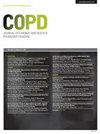重症监护病房慢性阻塞性肺病重症患者血清阴离子差距与死亡率之间的关系:来自 MIMIC IV 数据库的数据
IF 3.1
3区 医学
Q1 Medicine
International Journal of Chronic Obstructive Pulmonary Disease
Pub Date : 2024-02-29
DOI:10.2147/copd.s433619
引用次数: 0
摘要
背景:血清阴离子间隙(AG)已被证实与重症患者的预后有关。然而,很少有研究调查 AG 与慢性阻塞性肺病(COPD)重症患者全因死亡率之间的关系:我们假设最初的 AG 水平可预测 COPD 重症患者的死亡风险:这项回顾性队列研究基于重症监护医学信息市场(MIMIC)IV 数据库。我们提取了患者入住重症监护病房后 24 小时内的人口统计学特征、生命体征、实验室检查、合并症和评分系统。我们使用多变量逻辑回归分析模型来探讨血清 AG 水平与死亡率之间的关系。进行了包括年龄、性别和合并症在内的交互和分层分析:共纳入 5531 名慢性阻塞性肺病重症患者,其中男性占 53.6%,女性占 46.4%,中位年龄为 73 岁。这些患者在重症监护室住院期间的全因死亡率为 13.7%。在单变量逻辑回归分析中,全因死亡风险随着 AG 水平的增加而增加(OR=1.13,95% CI:1.11- 1.15,p< 0.01)。在多变量逻辑回归分析中对所有协变量进行调整后,几率比为 1.06(95% CI:1.04- 1.09,p< 0.01)。与最低 AG 组 Q1(≤ 11mmol/L)相比,Q2(12- 13mmol/L)、Q3(14- 15mmol/L)和 Q4(≥ 16mmol/L)的 AG 与死亡率的调整 OR 值分别为 0.89(95% CI:0.63- 1.25,p=0.502)、0.95(95% CI:0.68- 1.34,p=0.788)和 1.49(95% CI:1.10- 2.02,p=0.009)。此外,亚组和分层分析的结果也很可靠:AG与慢性阻塞性肺病重症患者的全因死亡率呈正相关。本文章由计算机程序翻译,如有差异,请以英文原文为准。
Association Between Serum Anion Gap and Mortality in Critically Ill Patients with COPD in ICU: Data from the MIMIC IV Database
Background: Serum anion gap (AG) has been proven to be associated with prognosis in critically ill patients. However, few studies have investigated the association between AG and all-cause mortality in critically ill patients with chronic obstructive pulmonary disease (COPD).
Objective: We hypothesized that the initial AG level would predict the mortality risk in critically ill patients with COPD.
Methods: This retrospective cohort study was based on the Medical Information Mart for Intensive Care (MIMIC) IV database. We extracted demographics, vital signs, laboratory tests, comorbidity, and scoring systems from the first 24 hours after patient ICU admission. Multivariable logistic regression analysis models were used to explore the association between serum AG levels and mortality. Interaction and stratified analyses were conducted including age, gender and comorbidity.
Results: A total of 5531 critically ill patients with COPD were enrolled, composed of 53.6% male and 46.4% female with a median age of 73 years. The all-cause mortality of these patients during ICU hospitalization was 13.7%. The risk of all-cause mortality increased as the AG level increased in the univariate logistic regression analysis (OR=1.13, 95% CI: 1.11– 1.15, p< 0.01). After adjusting for all the covariates in multivariate logistic regression analysis, the odds ratio was 1.06 (95% CI: 1.04– 1.09, p< 0.01). Compared with the lowest AG group Q1 (≤ 11mmol/L), the adjusted OR value for AG and mortality in Q2 (12– 13mmol/L) was 0.89 (95% CI: 0.63– 1.25, p=0.502), Q3 (14– 15mmol/L) was 0.95 (95% CI: 0.68– 1.34, p=0.788), and Q4 (≥ 16mmol/L) was 1.49 (95% CI: 1.10– 2.02, p=0.009) respectively. In addition, the results of the subgroup and stratified analyses were robust.
Conclusion: AG is positively related to all-cause mortality in critically ill patients with COPD.
Objective: We hypothesized that the initial AG level would predict the mortality risk in critically ill patients with COPD.
Methods: This retrospective cohort study was based on the Medical Information Mart for Intensive Care (MIMIC) IV database. We extracted demographics, vital signs, laboratory tests, comorbidity, and scoring systems from the first 24 hours after patient ICU admission. Multivariable logistic regression analysis models were used to explore the association between serum AG levels and mortality. Interaction and stratified analyses were conducted including age, gender and comorbidity.
Results: A total of 5531 critically ill patients with COPD were enrolled, composed of 53.6% male and 46.4% female with a median age of 73 years. The all-cause mortality of these patients during ICU hospitalization was 13.7%. The risk of all-cause mortality increased as the AG level increased in the univariate logistic regression analysis (OR=1.13, 95% CI: 1.11– 1.15, p< 0.01). After adjusting for all the covariates in multivariate logistic regression analysis, the odds ratio was 1.06 (95% CI: 1.04– 1.09, p< 0.01). Compared with the lowest AG group Q1 (≤ 11mmol/L), the adjusted OR value for AG and mortality in Q2 (12– 13mmol/L) was 0.89 (95% CI: 0.63– 1.25, p=0.502), Q3 (14– 15mmol/L) was 0.95 (95% CI: 0.68– 1.34, p=0.788), and Q4 (≥ 16mmol/L) was 1.49 (95% CI: 1.10– 2.02, p=0.009) respectively. In addition, the results of the subgroup and stratified analyses were robust.
Conclusion: AG is positively related to all-cause mortality in critically ill patients with COPD.
求助全文
通过发布文献求助,成功后即可免费获取论文全文。
去求助
来源期刊

International Journal of Chronic Obstructive Pulmonary Disease
RESPIRATORY SYSTEM-
CiteScore
5.10
自引率
10.70%
发文量
372
审稿时长
16 weeks
期刊介绍:
An international, peer-reviewed journal of therapeutics and pharmacology focusing on concise rapid reporting of clinical studies and reviews in COPD. Special focus will be given to the pathophysiological processes underlying the disease, intervention programs, patient focused education, and self management protocols. This journal is directed at specialists and healthcare professionals
 求助内容:
求助内容: 应助结果提醒方式:
应助结果提醒方式:


